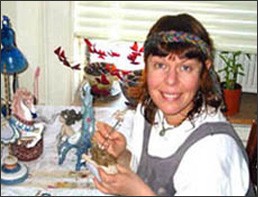China dolls should be properly called “glazed porcelain dolls” for there’s no substance known to ceramic manufacturers as “china”. Still there’s a logical wisdom to this popular term used by doll manufacturers, collectors and china repair experts everywhere to distinguish between heads made from proper porcelain (china) and unglazed porcelain (bisque).
Type of China Dolls
There are four grades of china: blue, white, creamy white and flesh-toned, the latter also called “pink luster”. China Head Dolls are molded in clay, glazed, and then fired at a high temperature in a kiln. The all-over coloring and the evenness of its tone is indicative of the grade of the finished article. Blue-white being common, the creamy being better, and the pink luster the best. Although we call them dolls, we are actually discussing and defining doll heads. Most china dolls have bodies made of cloth. But there are also China Limb Dolls, which are china-head dolls with lower arms and legs made of porcelain, and *Frozen Charlottes, the only all-porcelain dolls on the market. So when you contact a restorer specializing in doll repair be sure to let him or her know which part(s) of the doll is damaged and whether it’s cloth, plastic or china. If the damage is to the non-porcelain body of the doll, you’re better off contacting a doll clinic whose specialty is cloth or plastic doll repair.
History of China Dolls
Because china dolls were produced in abundance for more than one hundred years, a good number survive today that defy artificial system of classification devised by modern collectors. Almost all china dolls made before 1981 were unmarked, a situation that invited all sorts of undocumented methods of classification and dating. Except for the tenuous clues provided by hair styles (the best guide is the indispensable Collector’s Encyclopedia of Dolls), it remains difficult to approximate the age of china dolls. There are additional signposts, however. The older shoulder heads were modeled with a deep breast plate so that the dolls could be dressed in the low-cut gowns popular in the first part of the 19th century. As a rule, then, the breastplate became shorter as the century progressed. In addition, it is believed that china dolls with oval-shaped pointed eyes are older than those with round eyes. Short thick necks are characteristic of shoulder heads made in the late 19th century and early 20th century, just as the so-called “low-brow” with painted hair covering the forehead, dates from the same period. A good doll repair specialist should be able to approximate the average age of your damaged doll.
Given the number of china dolls on the market today, rareness is determined by quality of porcelain, uniqueness of hair style and the finesse of brushstrokes. In addition, blond china heads are far less common that dark haired dolls, and swivel-neck china heads are more common than one-piece shoulder heads.
Frozen Charlottes
Frozen Charlottes are one piece porcelain dolls that are completely unjointed. Known also as “pillar dolls”, “solid china dolls” or “bathing babies”, they were produced either glazed or unglazed. Most Frozen Charlottes are chubby nudes of undetermined sex with clenched fists and bent elbows. The wide variety of hairstyles would suggest that the dolls were determined to be female. Although it should be remembered that a lot of 19th century children were dressed and coiffed identically. Serious doll collectors who say they can determine the sex of a Frozen Charlotte just by looking at the doll call the male “Charlotte” Frozen Charlie. Pillar dolls range from one to over eighteen inches high and occasionally wear molded bonnets and hair ribbons, despite their nudity. Of the several explanations of the term “Frozen Charlotte”, the most plausible derives from Civil War ballad about “fair Charlotte”, who, eager to be wooed by her suitor one winter’s night, went out into the Vermont cold wearing only a silken cloak and promptly froze to death.


Speak Your Mind